Abstract
In vitro and in vivo antifungal activities of D0870 were evaluated in comparison with those of fluconazole. D0870, which is the R-enantiomer of ICI195,739, was found to be the mycologically active enantiomer by comparing the activities of D0870 with those of M16355 (S-enantiomer of ICI195,739). D0870 showed a broad spectrum of antifungal activity and MICs and minimum antibiotic concentrations 4- to 2,000-fold lower in synthetic amino acid medium (fungal) agar than those of fluconazole for various fungi. Although MICs of D0870 were affected by variation of the test conditions, such as type of medium, inoculum size of fungi, supplementation with fetal bovine serum, and pH of medium, they were consistently much lower than those of fluconazole under any condition. In vivo activities of D0870 in the systemic infection models with Candida albicans, Cryptococcus neoformans, and Aspergillus fumigatus in normal mice and in the mice immunosuppressed with cyclophosphamide or cortisone acetate were 2- to 7-fold and 3- to 89-fold greater than those of fluconazole, respectively. In these infection models in immunosuppressed mice, the therapeutic efficacy of D0870 was almost equivalent to that in normal mice, whereas the efficacy of fluconazole was 2- to 50-fold lower than that in normal mice.
Full text
PDF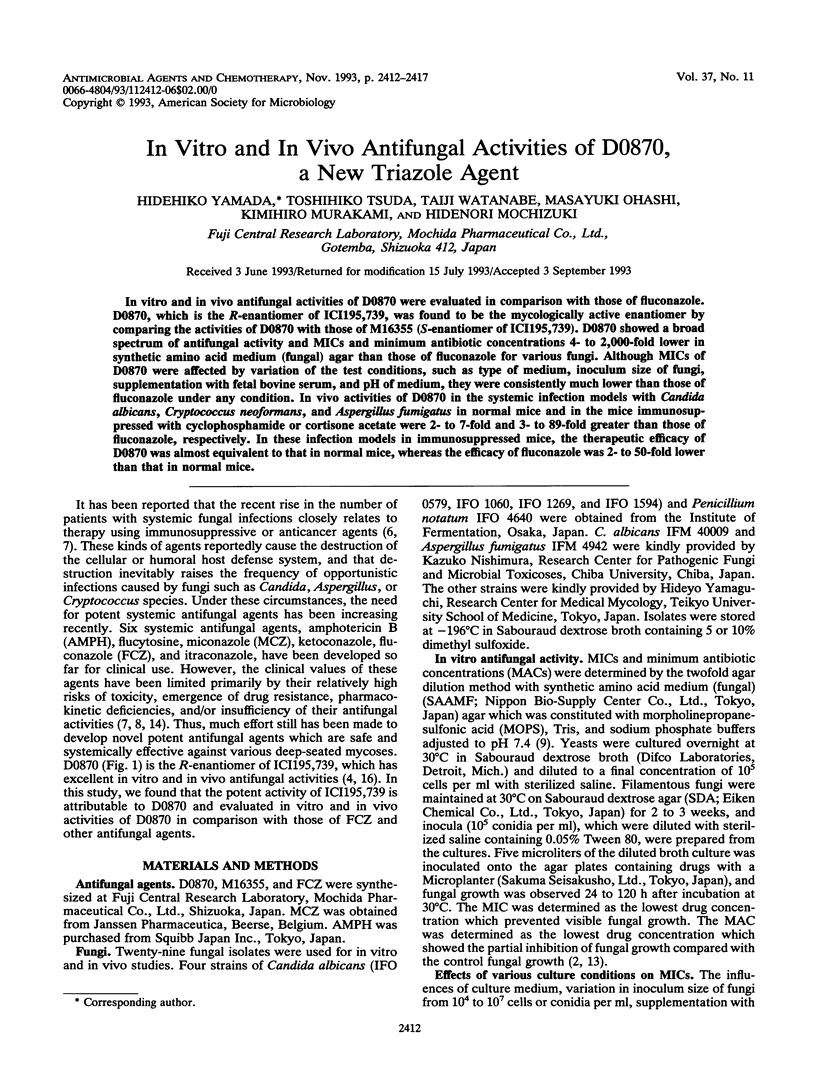
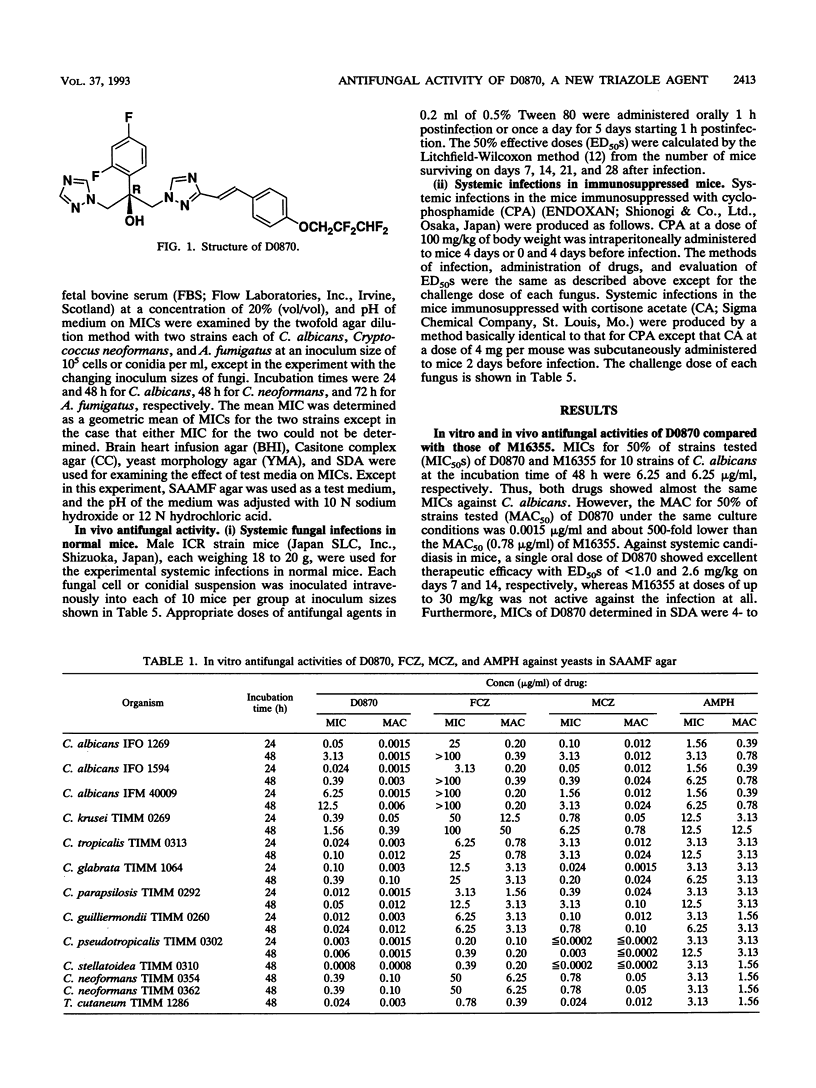
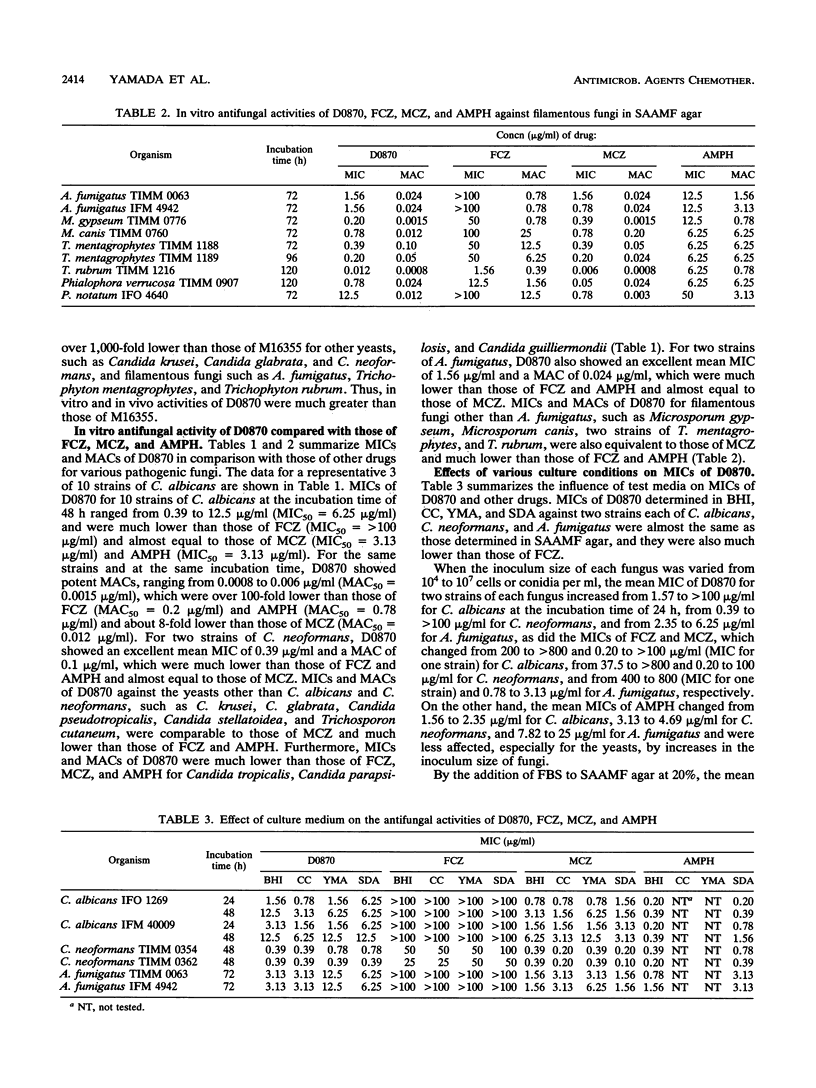
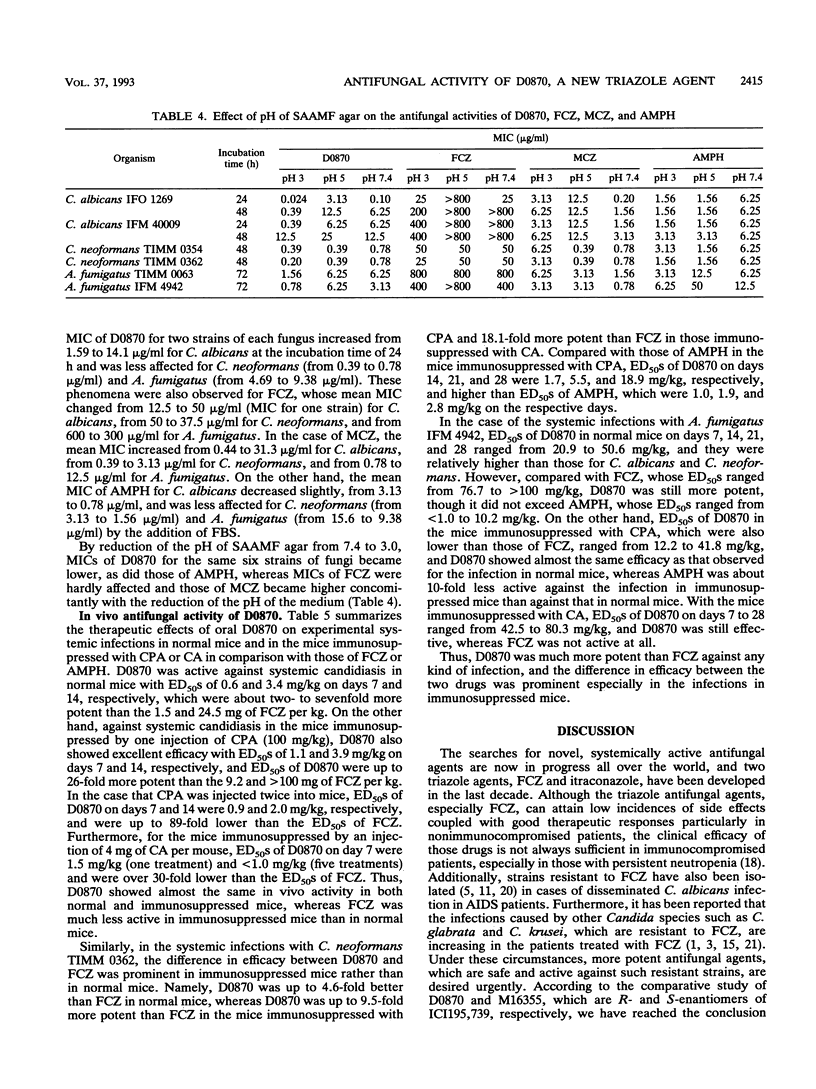
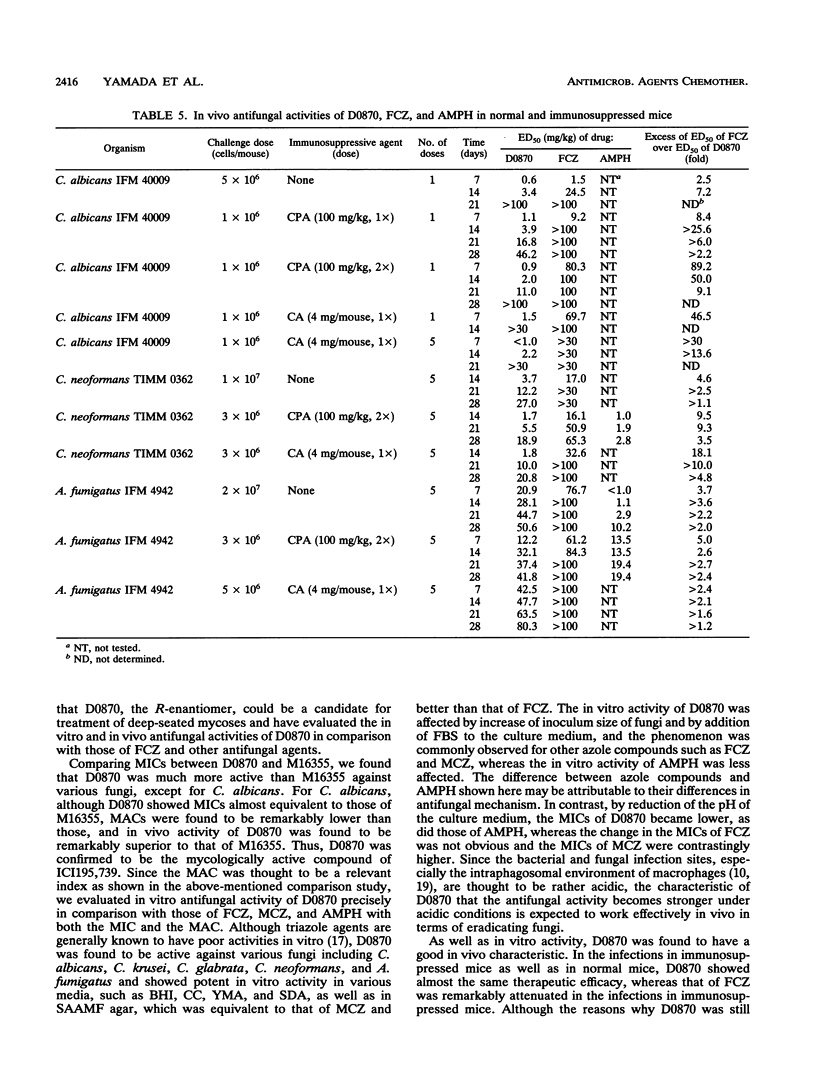
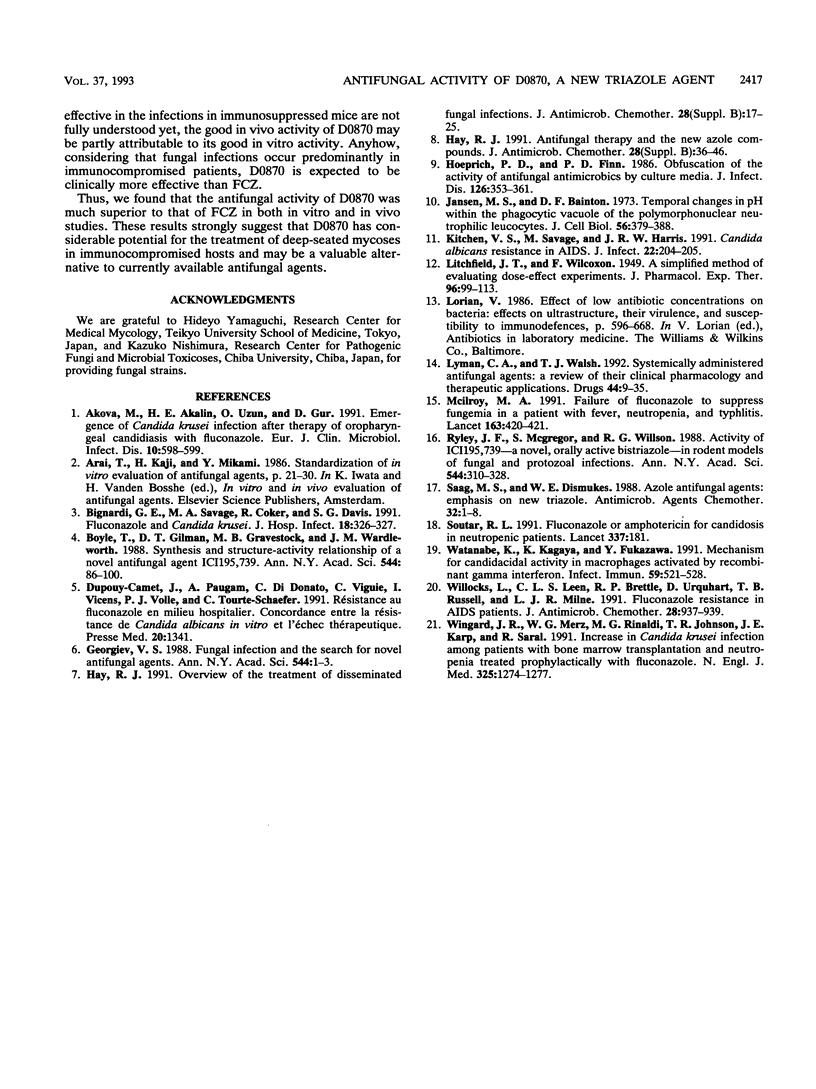
Selected References
These references are in PubMed. This may not be the complete list of references from this article.
- Akova M., Akalin H. E., Uzun O., Gür D. Emergence of Candida krusei infections after therapy of oropharyngeal candidiasis with fluconazole. Eur J Clin Microbiol Infect Dis. 1991 Jul;10(7):598–599. doi: 10.1007/BF01967286. [DOI] [PubMed] [Google Scholar]
- Bignardi G. E., Savage M. A., Coker R., Davis S. G. Fluconazole and Candida krusei infections. J Hosp Infect. 1991 Aug;18(4):326–327. doi: 10.1016/0195-6701(91)90193-c. [DOI] [PubMed] [Google Scholar]
- Boyle F. T., Gilman D. J., Gravestock M. B., Wardleworth J. M. Synthesis and structure-activity relationships of a novel antifungal agent, ICI 195,739. Ann N Y Acad Sci. 1988;544:86–100. doi: 10.1111/j.1749-6632.1988.tb40391.x. [DOI] [PubMed] [Google Scholar]
- Dupouy-Camet J., Paugam A., Di Donato C., Viguié C., Vicens I., Volle P. J., Tourte-Schaefer C. Résistance au fluconazole en milieu hospitalier. Concordance entre la résistance de Candida albicans in vitro et l'échec thérapeutique. Presse Med. 1991 Sep 14;20(28):1341–1341. [PubMed] [Google Scholar]
- Hay R. J. Antifungal therapy and the new azole compounds. J Antimicrob Chemother. 1991 Jul;28 (Suppl A):35–46. doi: 10.1093/jac/28.suppl_a.35. [DOI] [PubMed] [Google Scholar]
- Hay R. J. Overview of the treatment of disseminated fungal infections. J Antimicrob Chemother. 1991 Oct;28 (Suppl B):17–25. doi: 10.1093/jac/28.suppl_b.17. [DOI] [PubMed] [Google Scholar]
- Hoeprich P. D., Finn P. D. Obfuscation of the activity of antifungal antimicrobics by culture media. J Infect Dis. 1972 Oct;126(4):353–361. doi: 10.1093/infdis/126.4.353. [DOI] [PubMed] [Google Scholar]
- Jensen M. S., Bainton D. F. Temporal changes in pH within the phagocytic vacuole of the polymorphonuclear neutrophilic leukocyte. J Cell Biol. 1973 Feb;56(2):379–388. doi: 10.1083/jcb.56.2.379. [DOI] [PMC free article] [PubMed] [Google Scholar]
- Kitchen V. S., Savage M., Harris J. R. Candida albicans resistance in AIDS. J Infect. 1991 Mar;22(2):204–205. doi: 10.1016/0163-4453(91)91789-z. [DOI] [PubMed] [Google Scholar]
- Lyman C. A., Walsh T. J. Systemically administered antifungal agents. A review of their clinical pharmacology and therapeutic applications. Drugs. 1992 Jul;44(1):9–35. doi: 10.2165/00003495-199244010-00002. [DOI] [PubMed] [Google Scholar]
- McIlroy M. A. Failure of fluconazole to suppress fungemia in a patient with fever, neutropenia, and typhlitis. J Infect Dis. 1991 Feb;163(2):420–421. doi: 10.1093/infdis/163.2.420. [DOI] [PubMed] [Google Scholar]
- Ryley J. F., McGregor S., Wilson R. G. Activity of ICI 195,739--a novel, orally active bistriazole--in rodent models of fungal and protozoal infections. Ann N Y Acad Sci. 1988;544:310–328. doi: 10.1111/j.1749-6632.1988.tb40416.x. [DOI] [PubMed] [Google Scholar]
- Saag M. S., Dismukes W. E. Azole antifungal agents: emphasis on new triazoles. Antimicrob Agents Chemother. 1988 Jan;32(1):1–8. doi: 10.1128/aac.32.1.1. [DOI] [PMC free article] [PubMed] [Google Scholar]
- Soutar R. L. Fluconazole or amphotericin for candidosis in neutropenic patients. Lancet. 1991 Jan 19;337(8734):181–181. doi: 10.1016/0140-6736(91)90851-f. [DOI] [PubMed] [Google Scholar]
- St Georgiev V. Fungal infections and the search for novel antifungal agents. Opening remarks. Ann N Y Acad Sci. 1988;544:1–3. doi: 10.1111/j.1749-6632.1988.tb40384.x. [DOI] [PubMed] [Google Scholar]
- Watanabe K., Kagaya K., Yamada T., Fukazawa Y. Mechanism for candidacidal activity in macrophages activated by recombinant gamma interferon. Infect Immun. 1991 Feb;59(2):521–528. doi: 10.1128/iai.59.2.521-528.1991. [DOI] [PMC free article] [PubMed] [Google Scholar]
- Willocks L., Leen C. L., Brettle R. P., Urquhart D., Russell T. B., Milne L. J. Fluconazole resistance in AIDS patients. J Antimicrob Chemother. 1991 Dec;28(6):937–939. doi: 10.1093/jac/28.6.937. [DOI] [PubMed] [Google Scholar]
- Wingard J. R., Merz W. G., Rinaldi M. G., Johnson T. R., Karp J. E., Saral R. Increase in Candida krusei infection among patients with bone marrow transplantation and neutropenia treated prophylactically with fluconazole. N Engl J Med. 1991 Oct 31;325(18):1274–1277. doi: 10.1056/NEJM199110313251803. [DOI] [PubMed] [Google Scholar]


